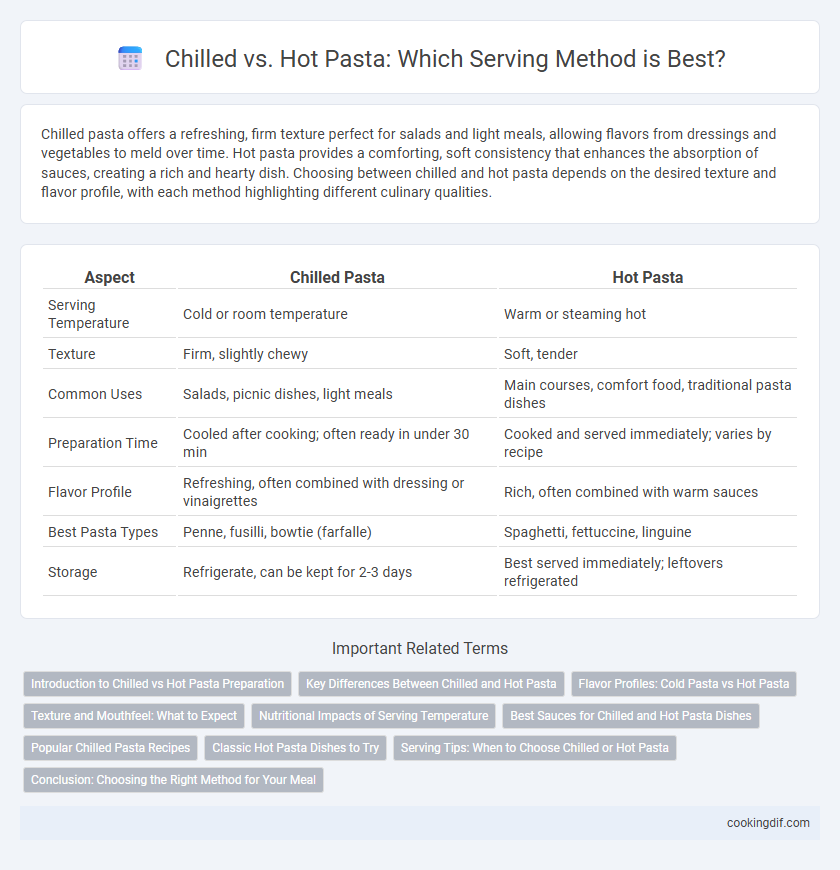Chilled pasta offers a refreshing, firm texture perfect for salads and light meals, allowing flavors from dressings and vegetables to meld over time. Hot pasta provides a comforting, soft consistency that enhances the absorption of sauces, creating a rich and hearty dish. Choosing between chilled and hot pasta depends on the desired texture and flavor profile, with each method highlighting different culinary qualities.
Table of Comparison
| Aspect | Chilled Pasta | Hot Pasta |
|---|---|---|
| Serving Temperature | Cold or room temperature | Warm or steaming hot |
| Texture | Firm, slightly chewy | Soft, tender |
| Common Uses | Salads, picnic dishes, light meals | Main courses, comfort food, traditional pasta dishes |
| Preparation Time | Cooled after cooking; often ready in under 30 min | Cooked and served immediately; varies by recipe |
| Flavor Profile | Refreshing, often combined with dressing or vinaigrettes | Rich, often combined with warm sauces |
| Best Pasta Types | Penne, fusilli, bowtie (farfalle) | Spaghetti, fettuccine, linguine |
| Storage | Refrigerate, can be kept for 2-3 days | Best served immediately; leftovers refrigerated |
Introduction to Chilled vs Hot Pasta Preparation
Chilled pasta preparation involves cooking pasta al dente, rapidly cooling it to preserve texture, and serving it cold with fresh ingredients, enhancing its refreshing qualities especially in salads and summer dishes. Hot pasta preparation emphasizes immediate serving after draining, combining the pasta with warm sauces to maximize flavor absorption and create comforting, rich meals. Understanding the distinct methods and serving temps highlights how temperature influences pasta's texture, flavor profile, and suitability for various culinary applications.
Key Differences Between Chilled and Hot Pasta
Chilled pasta offers a firmer texture and is often dressed with light, refreshing sauces like vinaigrettes or pesto, making it ideal for salads and summer dishes. Hot pasta provides a softer texture, enhancing the absorption of rich, creamy, or tomato-based sauces, which intensifies flavor and warmth. Temperature influences both the mouthfeel and sauce adhesion, with chilled pasta maintaining its structure while hot pasta becomes more pliable and tender.
Flavor Profiles: Cold Pasta vs Hot Pasta
Cold pasta enhances fresh, crisp flavors with a slightly firmer texture that complements vinaigrettes, herbs, and raw vegetables, making it ideal for refreshing salads. Hot pasta intensifies savory, rich profiles as heat releases aromatic oils from sauces and softens ingredients, creating a harmonious blend of flavors and a comforting mouthfeel. The temperature difference significantly influences the perception of acidity, spice, and texture, shaping the overall dining experience.
Texture and Mouthfeel: What to Expect
Chilled pasta offers a firmer, more al dente texture with a refreshing bite, enhancing the contrast when paired with crisp vegetables or creamy dressings. Hot pasta, by contrast, provides a softer, more tender mouthfeel as heat loosens the starches, allowing sauces to cling more effectively and create a harmonious blend. The temperature directly influences moisture retention and stiffness, which plays a crucial role in the overall sensory experience of the dish.
Nutritional Impacts of Serving Temperature
Serving pasta chilled preserves more resistant starch, which can improve gut health by acting as a prebiotic fiber, while hot pasta tends to have a higher glycemic index causing quicker blood sugar spikes. Cooling cooked pasta increases resistant starch content by up to 20%, lowering its overall calorie impact and supporting better glucose metabolism. Nutrient retention remains similar, but serving temperature affects digestion speed and satiety levels, influencing metabolic responses.
Best Sauces for Chilled and Hot Pasta Dishes
Chilled pasta dishes pair best with light, fresh sauces such as pesto, vinaigrette, or citrus-based dressings that enhance the ingredients without overwhelming their textures. Hot pasta is ideal for rich, hearty sauces like marinara, Alfredo, or Bolognese, which meld flavors through warmth and create a comforting, satisfying meal. Choosing the right sauce complements the served temperature, maximizing flavor and texture harmony in pasta dishes.
Popular Chilled Pasta Recipes
Chilled pasta recipes like pasta salad and pesto pasta are popular for their refreshing flavors and easy preparation, often featuring ingredients such as cherry tomatoes, olives, fresh basil, and mozzarella. These dishes are typically served cold or at room temperature, making them ideal for picnics, summer lunches, and quick meals. The cold preparation preserves the texture of pasta and enhances the vibrant taste of fresh herbs and crisp vegetables.
Classic Hot Pasta Dishes to Try
Classic hot pasta dishes such as Spaghetti Carbonara, Fettuccine Alfredo, and Penne Arrabbiata showcase the rich flavors and creamy textures best appreciated warm. Serving pasta hot enhances the melding of fresh ingredients like Parmesan cheese, garlic, and olive oil, creating a comforting and aromatic experience. While chilled pasta salads offer a refreshing alternative, traditional Italian meals are defined by the steaming presentation of freshly cooked pasta with vibrant sauces.
Serving Tips: When to Choose Chilled or Hot Pasta
Chilled pasta works best in pasta salads or light dishes where fresh vegetables and herbs enhance flavor and texture, making it ideal for warm weather or outdoor meals. Hot pasta suits hearty sauces like marinara or Alfredo that benefit from warmth to intensify flavors and create a comforting dining experience. For optimal taste and texture, serve chilled pasta immediately after cooling, while hot pasta should be served promptly to maintain its softness and sauce absorption.
Conclusion: Choosing the Right Method for Your Meal
Chilled pasta dishes excel in refreshing flavors and ideal texture for salads or light meals, while hot pasta enhances richness and comfort, perfect for hearty sauces and main courses. Selecting the preparation method depends on the desired taste profile and occasion, with chilled versions offering convenience and crispness, and hot pasta delivering warming satisfaction. Understanding these differences ensures your pasta complements the overall dining experience effectively.
Chilled vs hot preparation for serving Infographic

 cookingdif.com
cookingdif.com